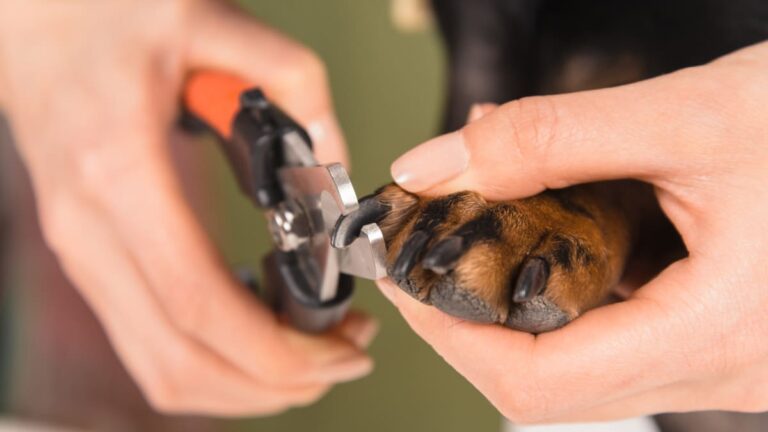When you buy through our links, Business Insider may earn an affiliate commission. , is a great pair to get you started with a small or medium-sized dog. These plier-style clippers are easy to use, have a safety guard, and make smooth cuts.
Learn more about how Business Insider Reviews and . The Resco blade was very sharp and cut the nail smoothly, while the Millers Forge blade didn’t seem as sharp or cut as smoothly.
Even though the Resco clippers lack a rubber grip on the handles, they were comfortable to hold and easy to squeeze closed, like my other picks for the best dog nail clippers. They’re also designed to last, with chrome-plated American steel manufactured in the US. You can purchase a .
The Dremel grinder comes with band attachments for more maneuverability, but they require more skill and confidence as they cannot be used with the guard attachments. I used the grinder with both options and preferred the performance and peace of mind of the grinding disc.
Jackie Brown/Business Insider
The kit comes with a variety of sanding bands and discs, but the product’s real standout is the nail safety guard and paw guide, which helped me attain a good nail trimming angle. Nail grinders have a learning curve, but Dremel’s Quick Start Guide is helpful and recommends specific attachments and speeds for beginning users. As with all nail grinders, the grinding heads need occasional replacement. Professional groomers will need to replace these more often; for pet owners, they should last a long time.
Read my at the time of my interview, recommends using the tool you feel most comfortable with, which will make your dog most comfortable.
How do I care for dog nail clippers and grinders?
After each use, wipe your clippers clean. Close the clippers and engage the safety lock to protect the blade when not in use. If your nail clippers get wet, dry them thoroughly before storing them indoors in a plastic or cloth bag with all of the grinding accessories. If nail clippers or grinders are left outside and exposed to dampness and temperature extremes, the metal can rust, and the plastic can warp.
How often should I trim my dog’s nails?
This depends on your dog, but the general rule of thumb is to trim your dog’s nails before they grow long enough to click on the floor. All nails grow at different rates, and dogs wear them down differently. Big, heavy dogs that run around outside may naturally wear their nails down, requiring less frequent trimming. “A Yorkie that barely touches the ground most days might need a nail trim every two weeks,” says Smits. “An Iditarod training or marathon running pal might never need one.”
How far down do I cut the nail?
Trim the nail as short as you can without cutting into the quick, which is the vein that runs down the center of the nail. If your dog has white nails, it’s easy to see the quick. If your dog has black nails, it’s harder to know precisely how far to cut. Conservatively clip just the hooked part of the nail to be safe. You can also ask your veterinarian for a demonstration on your dog. For more detailed directions, check out our tutorial on how to cut or grind your dog’s nails the right way.
When should I start trimming my puppy’s nails?
Start nail trimming as early as possible so your puppy learns to accept it. Even older dogs can learn to accept nail trimming if you approach it the right way. “Introduce the dog to the nail trimming procedure in a slow, fun, rewarding manner,” Smits says. “This will enable the dog to fall in love with the attention that comes with getting a pedicure and time with you.”
Does nail trimming hurt my dog?
As long as you don’t cut too far down, it hurts no more than trimming your own nails. However, be very careful not to cut the quick. The quick is extremely sensitive. Cutting into it is painful and will cause the nail to bleed. It may also cause your dog to become resistant to nail trimming in the future.
What should I do if I cut my dog’s nail and it starts to bleed?
If you accidentally nick the quick, use styptic power to cauterize it and stop the bleeding. Scoop up a small amount of powder onto your finger or with a piece of gauze and press it gently but firmly against the nail. Hold for a minute or so until the bleeding stops. If you don’t have styptic powder, you can use flour or corn starch instead.
I’m too nervous to trim my dog’s nails. Who will do it for me?
If you are uncomfortable trimming your dog’s nails or are concerned your pet might bite if you try to trim their nails, seek professional help. Most groomers include nail trimming in their regular services. You can also make an appointment to have your dog’s nails trimmed at your veterinary hospital. “If the dog is an amiable sort, groomers are a phenomenal option,” Smits says. However, dogs who may become aggressive during nail trimming would benefit from a trim at the vet’s office where they can use sedation if necessary.
